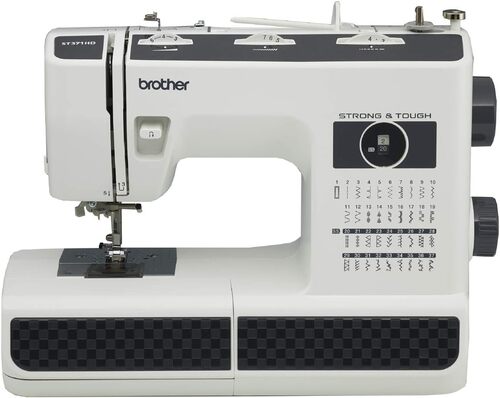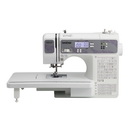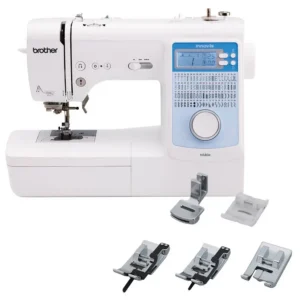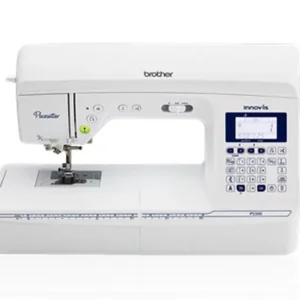
I still remember the morning the big brown box showed up on my doorstep. For weeks I’d been scrolling through Brother ST371HD reviews, bouncing between “this is the one” and “am I buying too much machine?” My old Kenmore had finally coughed its last stitch on a pair of jeans, so it was time. I wanted something simple, tough, and not fussy. The model that kept popping up in every search: the Brother ST371HD sewing machine.
Unboxing jitters, then a grin
Lifting the lid felt like opening a toolbox. Nothing flashy — just solid. The Brother sewing machine ST371HD looked practical in the best way: sturdy frame, clear markings, and a drop-in bobbin I could see through. The accessory pouch had the six feet I actually use: the spring-action zigzag, zipper, blind-hem, nonstick (hello vinyl), buttonhole, and button-sewing foot. There were a few needles, some bobbins (I immediately wished there were more), the manual, and a little DVD. I don’t even have a DVD drive anymore, but the printed guide, plus the diagrams stamped right on the machine, turned out to be enough.
First thread, first sigh of relief
Threading always used to raise my blood pressure. On the ST371HD, the numbered path is etched along the front — follow the arrows and you’re basically done. The auto needle threader took me a minute to “get” (tip: pull it down firmly and let the tiny hook find the eye; it’s happier with size 14–18 needles than super-fine ones), but once it clicked, so did I. Winding a bobbin was easy. I liked hearing that soft “hum” instead of a rattle.
The foot pedal is light and the cord isn’t long, so I stuck a non-slip mat under it. Problem solved.
Love at first hem
I broke the ice on a pair of jeans that had been mocking me from a chair. I snapped off the flatbed for the free arm, slid the leg over it, and stitched away. No skipped stitches, no snarls. The feed was steady over the thick side seams as long as I slowed down a touch and used a 16 denim needle. I’d forgotten how satisfying a clean hem feels — like a tiny superpower.
The “tough” test
Everyone online seems to put this model through a torture test, so I did too. I had to finish vinyl banner pockets for a community project — eight layers at the folds. I switched to the nonstick foot, loaded upholstery thread with an 18 needle, and held my breath. The Brother ST371HD didn’t flinch. It climbed the hump and kept going. It squeaked at me once when I crept too slowly, but that was my foot, not the motor. Later I stitched canvas straps and a zipper into a tote: again, steady, no drama. If you’re here for a real-world Brother ST371HD review: yes, it handles heavy stuff — provided you match the needle and thread to the job.
Getting playful with the 37 stitches
This isn’t a computerized machine with a thousand patterns, and I didn’t want that. The 37 built-in stitches are the “doers”: straight, zigzag, stretch stitches, blind hems, a few decorative edges. I used zigzag with Heat-n-Bond to applique numbers onto a kid’s jersey and it looked neat, not puckered. The buttonhole is one-step with the included foot; it took a couple scraps to dial in the width I liked, but once set, it was consistent. If you crave a gazillion fancy motifs, look elsewhere. If you want clean stitches you’ll use every week, this is plenty.
Little quirks you should know
No machine is perfect, and honesty helps more than hype:
- Needle threader: smooth with standard/denim needles; fussy with very fine “sheer” needles. I just hand-thread those.
- Reverse lever: it’s on the right and a bit stiff at first. It loosened up after a few nights of sewing.
- Plastic bits: the presser-foot lifter and pedal feel light. They work, but I treat them with respect.
- Lighting: it could be brighter. I added a clip-on lamp and now I can sew black thread on black fabric without guessing.
- No auto thread cutter: I keep snips on a magnetic hook and don’t miss it anymore.
- Tension is picky about cheap thread: with decent thread (Gutermann/Coats) and the correct needle, my seams look textbook.
A tiny scare, a quick fix
After a marathon of buttonholes on a denim jacket, the machine decided it only wanted to sew in reverse. Panic. Two deep breaths and a quick search later, I learned to turn the handwheel back and forth a few times to reset the mechanism. It worked. Now I always return the buttonhole lever properly and haven’t had that hiccup again.
Teaching and traveling
One reason I wanted the ST371HD was to teach my niece. The mechanical dial for stitches, the simple tension wheel, and the free arm make it beginner-friendly without being “toy-ish.” We practiced on cotton squares, then jumped to a zipper pouch with canvas. She learned to guide fabric instead of fighting it. The machine is light enough to carry to her house, but heavy enough not to skate across the table.
Three months in: the groove
Since unboxing, I’ve hemmed jeans, pieced a small quilt top, added piping to pillow covers, repaired an outdoor swing cover, and stitched a faux-leather tote. I change needles often, brush out the bobbin area, and keep a few extra bobbins pre-wound with my staple colors because — real talk — this machine uses a specific size and mixing brands can throw things off. Routine TLC keeps it happy.
What I wish someone told me sooner
- Use the nonstick foot for anything sticky (vinyl, coated fabrics). Night and day difference.
- If you’re hopping thick-to-thin, slow down at the cliff and let the feed dogs catch up. A little hand-wheel assist is not cheating.
- Keep a pack of Organ or Schmetz needles in sizes 12–18 and match the needle to the fabric. Most “machine problems” vanished when I did this.
- Put a strip of washi tape on the bed as a bold seam guide — the tiny marks are accurate but low-contrast.
- Buy extra bobbins now, not mid-project.
So… would I buy it again?
Yes. For me, the Brother ST371HD hits that sweet spot of simple, durable, and capable. It’s not fancy and doesn’t pretend to be. It sews a straight line beautifully, bites into heavy layers when asked, and keeps its cool with everyday repairs and crafty projects. If you’re reading a million Brother ST371HD reviews and wondering whether this model is just marketing: from my sewing table, it’s the real deal.
My bottom line Brother ST371HD review:
- Great for: beginners to confident hobbyists; denim hems, canvas totes, vinyl pockets, zippers, everyday mending.
- Good to know: treat the needle threader gently, use decent thread, add a lamp, and don’t expect computerized bells and whistles.
- Value: high. It feels like a small, reliable workhorse that pays for itself in saved alterations and “I made that” moments.
If you need a genuine partner that shows up for real-world sewing — without a steep learning curve — the Brother ST371HD is that dependable friend. I bought it to get things done, and now I keep finding reasons to sew more.
Brother ST371HD: Pros & Cons from Customer Feedback
| Pros (what customers like) | Cons (what customers don’t like / watch-outs) |
|---|---|
| Easy to set up and use — clear on-machine threading guides; beginner-friendly even for returners to sewing. | Durability concerns on some units — reports of cracked plastic parts (case, presser-foot lever, thread guide, hand wheel) and a broken spool holder. |
| Great value for the price — many call it a solid, no-frills workhorse under ~$200. | Needle threader can be fussy or fail — awkward with very fine needles; a few users say it broke. |
| Handles heavy fabrics better than expected — denim seams, canvas, upholstery, vinyl (even multiple layers) when paired with the right needle (16–18) and, when needed, the nonstick foot. | Feeding issues in specific scenarios — struggles over small doubled pleats or thick/thin transitions; some note soft/wearing feed dogs over time. |
| Versatile for everyday projects — 37 stitches + 6 feet cover repairs, apparel, bags, piping, zippers, simple quilting, and applique. | No presser-foot pressure adjustment — limits fine tuning for very light or very thick materials. |
| Free arm is handy for cuffs/sleeves and small items. | Buttonhole complaints — inconsistent results; some report the cycle keeps sewing past the endpoint. |
| Smooth, even seams & relatively quiet — many praise stitch quality on multiple fabric types. | Reverse lever quirks — stiff feel for some; rare “stuck sewing in reverse” glitch that needed a hand-wheel reset. |
| Mechanical simplicity — fewer electronics to baby; good backup to computerized machines and great for teaching. | Tension/thread break issues if setup or thread quality is poor; picky with cheap thread. |
| Clear drop-in bobbin & winding is straightforward (for most); on-machine diagrams help. | Bobbin caveats — a few under-filled windings, bouncing bobbins, difficulty pulling bobbin thread up; must use correct bobbin type. |
| Portable/lightweight yet stable — rubber base helps keep it planted; easy to travel with. | Lighting is dim for some; many add a clip-on lamp. |
| Good documentation overall — detailed manual; DVD included (helpful for some). | DVD feels outdated & support mixed — some wanted downloadable videos; parts/service availability can be inconvenient. |
| Applique & decorative basics work nicely — clean zigzag with Heat-n-Bond; neat edges on craft projects. | Ergonomics/space nitpicks — tight clearance at needle, short free-arm height, right-side presser-foot lever placement bothers some. |
| Works well with quality needles/thread — Organ/Schmetz + good thread solved many user issues. | Missing features/accessories — no auto thread cutter; light foot-pedal with short cord; no case included; occasional missing parts on arrival. |
| Reliable for quilting basics & piecing — multiple users completed quilts, bags, and heavy home-dec items. | Not industrial — will tackle “heavy-duty household” tasks, but true leather/welding aprons still call for an industrial machine. |
Brother ST371HD — Your Most-Asked Questions Answered
What is the Brother ST371HD and who is it for?
The Brother ST371HD is a mechanical, Strong & Tough household sewing machine designed for everyday sewing with some heavy-duty tasks. It’s ideal for beginners who want a simple, reliable starter and for experienced sewists who need a no-nonsense backup. If you’re reading Brother ST371HD reviews, think of it as a practical workhorse rather than a flashy computerized model—great value for mending, apparel, bags, home-dec, and denim.
How many stitches and feet does it include?
It offers 37 built-in stitches (straight, zigzag, stretch, blind hem, overedge, decorative, triple stretch, etc.) and comes with multiple presser feet such as zigzag (J), buttonhole (A), zipper (I), button-sew (M), blind-hem, plus a nonstick/Teflon foot on many bundles. That’s enough variety for most everyday projects without complexity.
Does it make buttonholes?
Yes. The Brother ST371HD sewing machine has a 1-step automatic buttonhole with a fine-adjustment screw to tweak density/fit. Use the buttonhole foot, set stitch length in the F–1 range, and test on scrap for best results.
Does the Brother ST371HD have a free arm?
Yes. Slide off the flat-bed attachment to use the free arm for cuffs, sleeves, small tubes, and hard-to-reach areas—super handy for hemming jeans and kid clothes.
What type of bobbin does the Brother sewing machine ST371HD use?
Use only Brother SA156 (SFB: XA5539-151) 11.5 mm plastic drop-in bobbins. Other types can cause tension issues, poor winding, or damage. Always wind evenly and thread the bobbin through the built-in cutter path before sewing.
How do I thread the Brother ST371HD?
Follow the numbered thread path printed on the machine: spool → guides → down and up through the take-up lever → needle bar guide → needle. Raise the presser foot to open tension discs, and keep the needle at top-dead-center (handwheel mark up). The built-in needle threader works with 75/11–100/16 needles; for very fine or specialty needles, thread by hand.
Can I use a twin needle?
Yes. Install the included extra spool pin and a compatible twin needle (e.g., 2.0/75). Use zigzag foot J, keep stitch width ≤2.5, and thread each needle separately (right thread skips the last guide). Do not use the needle threader with a twin needle.· Brother sewing machine ST371HD)
Is there a presser-foot pressure adjustment?
No manual pressure dial is listed for the Brother ST371HD. For thin or thick materials, use the correct needle/thread combo, adjust stitch length, and raise the presser foot to its extra-high position when placing bulky layers. A stabilizer under very thin fabrics also helps feed smoothly.
What fabrics can it handle?
With the right needle and thread, it sews thin cottons, broadcloth, knits, denim, canvas, and even vinyl/leather-look materials for home projects. Use ball-point needles for knits, 90/14–100/16 for denim/canvas, and quality thread. For heavy seams or thick-to-thin transitions, slow down and guide—don’t push/pull—to avoid needle deflection.
How do I adjust thread tension?
Use the upper tension dial: lower numbers loosen, higher numbers tighten. Loops on the fabric front mean upper tension is too tight; loops on the back mean it’s too loose. If problems persist, rethread both top and bobbin and confirm the correct bobbin type and insertion path. Test on scrap first.
Does it drop the feed dogs for buttons/darning?
Yes. There’s a feed-dog position switch: up for normal sewing, down for darning or sewing on buttons. After raising the dogs again, turn the handwheel once so they come back up fully.
How do I start and stop, and is there speed control?
The Brother ST371HD uses a foot controller (KD-1902/KD-2902 depending on region). Light pressure = slow, more pressure = faster. The machine starts/stops with your foot only—no separate start/stop button or speed slider. Keep the area around the pedal clear for safety.
Is there an automatic thread cutter or needle-down button?
There’s a manual side thread cutter for snipping tails, but no electronic auto-cut or programmable needle-down. After stitching, raise the needle with the handwheel, lift the presser foot, pull fabric to the left, and use the built-in cutter.
What maintenance does Brother recommend?
Unplug after use; keep vents and the foot controller free of lint/dust; clean the bobbin area regularly with the included brush; store away from heat/humidity and direct sun; use only neutral cleaners on the case; consult the troubleshooting table before service. If the LED light unit is damaged, have an authorized dealer replace it.
Which needles and threads should I choose?
Match needle and thread to fabric: 65/9–75/11 with fine thread for light fabrics; 75/11–90/14 for medium; 90/14–100/16 with 30–50 weight thread for thick fabrics like denim. Use ball-point for knits. Avoid very heavy (≤#20) thread and pair transparent nylon with 90/14–100/16.
Any safety must-knows?
Always turn the power switch to O and unplug before cleaning, changing needles/feet, or when unattended. Keep fingers away from moving parts, never sew with a bent/damaged needle, don’t pull fabric while sewing, and plug directly into a wall outlet (no extension cords).
What’s included in the box?
Machine with zigzag foot J attached, buttonhole foot A, zipper foot I, button-sew foot M, blind-hem foot, extra spool pin, spool caps, bobbins, needle set, twin needle (on some versions), disc screwdriver, seam ripper, cleaning brush, foot controller, and soft/hard cover depending on region/bundle. Exact accessories can vary by model/package.
Where can I find official support and more how-tos?
Brother’s support portal has FAQs, troubleshooting, and additional guides. The operation manual also includes a full troubleshooting table, stitch charts, and part numbers you can reference during setup and sewing.· Brother ST371HD sewing machine)
Bottom line—what do real users say in Brother ST371HD reviews?
Most owners praise its ease of use, value, and ability to tackle denim/canvas/vinyl when paired with the right needle and settings. Common watch-outs include fussy needle threader with very fine needles, the need to use the correct SA156 bobbins, and that it’s a strong household machine—not an industrial unit.
| Specification | Details |
|---|---|
| Model | Brother ST371HD “Strong & Tough” mechanical free-arm sewing machine. |
| Built-in stitches | 37 stitches, including utility, stretch and decorative patterns; plus 1-step automatic buttonhole. |
| Stitch length | Continuously adjustable ~0–4 mm; “F–1” range for satin (closed zigzag) stitching. |
| Stitch width | Up to 6.5 mm (zigzag/decorative); straight/triple-stretch allow left-right needle position via width dial. |
| Buttonholes | 1-step automatic buttonhole with fine-adjustment screw. |
| Feed system | Feed-dog position switch (raise/lower) for normal sewing, darning, buttons, etc. |
| Reverse stitch | Reverse sewing lever for back-tacking and reinforcement. |
| Lighting | Integrated sewing light (LED unit noted in manual). |
| Bobbin system | Top-drop-in “Quick-set” bobbin; Bobbin type SA156 (SFB) 11.5 mm. |
| Needle system & sizes | Household sewing needles; typical range shown in fabric/thread/needle tables (e.g., 65/9–100/16; ball point for knits). |
| Needle threader | Built-in needle threader. |
| Twin-needle | Twin-needle capable; twin needle (2.0/75) listed in accessories. |
| Free arm | Yes – remove flat-bed attachment for cylindrical pieces (sleeves, hems). |
| Thread cutter | Built-in manual thread cutter. |
| Controls | Mechanical dials: pattern selection, stitch length, stitch width. |
| Foot controller | Variable-speed foot controller (KD-1902 for 110–120/127 V regions; KD-2902 for 220–240 V regions). |
| Power | Use only regular household electricity; main power & sewing-light switch on body. |
| Included accessories (typical) | Bobbin(s) SA156, needle set (incl. 90/14), twin needle 2.0/75, seam ripper, cleaning brush, disc-shaped screwdriver, foot controller; cover type (soft or hard) varies by package/region. |
| Optional accessories | Walking foot, quilting foot, 1/4″ quilting foot, narrow hemmer, quilting guide and more (availability by region). |




